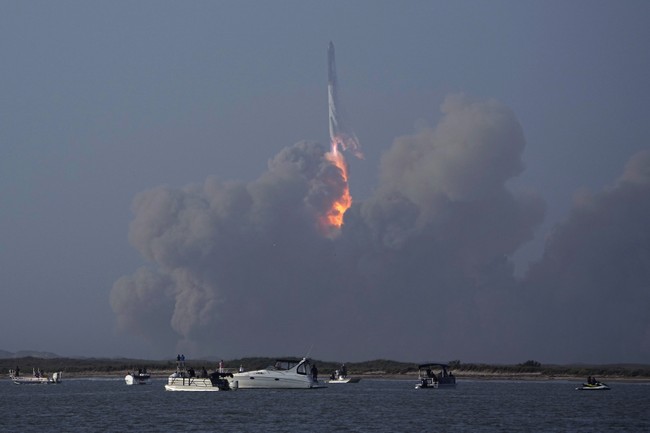
Yowza. It was amazing to watch the fourth test flight of SpaceX’s Starship. If you didn’t catch it live, don’t worry. You will see these images countless times over the coming hours and days.
Liftoff of Starship! pic.twitter.com/2Z1PdNPYPG
— SpaceX (@SpaceX) June 6, 2024
The launch was nothing short of stunning, in some ways rivaling the launch of a Saturn V launch vehicle and in other ways far more impressive.
Of course, the craft doesn’t carry men to the moon–yet, at least–and it is only in its test phase, so at this stage the emotional charge is hardly comparable.
That may change, though, if Starship fulfills its intended mission, which is to bring men to the moon from orbit and eventually get men to Mars.
First, let’s get a few things out of the way for those who haven’t been following the development of Starship as closely as us geeks: unlike the Saturn V and pretty much any vehicle made by the US government (through contractors, of course), SpaceX’s development strategy is vastly different.
NASA designs its spacecraft to work the first time they fly, so they are exquisitely engineered from the beginning. This has the advantage of making a craft that doesn’t tend to blow up for all the cameras to see, but also means that they are wildly expensive to develop, can take forever to build, and never meet budget targets.
Starship’s Raptor engines have ignited during hot-staging separation. Super Heavy is executing the flip maneuver and boostback burn pic.twitter.com/TsdIKpqLJH
— SpaceX (@SpaceX) June 6, 2024
SpaceX’s strategy is vastly different. The design process is iterative–start with a “good enough” design, test and break it, figuring out the strengths and weaknesses. Rinse, repeat.
NASA’s strategy got us to the moon–at an expense inconceivable to the mortal mind. It still blows our mind, and exhausting America’s taste for big projects and never, ever getting us close to easy and regular access to space. In fact, NASA still can’t provide easy and cheap access to space.
SpaceX revolutionized the space industry and is still incalculably ahead of any competitor. This year, the company will launch about 90% of the mass sent to space. Every country on Earth and every private competitor combined will launch 1/9th of what Elon Musk’s company does. The US government itself relies on SpaceX for access to space, and the US military is likely SpaceX’s protector against the Biden administration’s vendetta against Musk.
Hot stage jettison pic.twitter.com/J48QtQD1Ae
— SpaceX (@SpaceX) June 6, 2024
Should Starship come close to meeting Musk’s rather optimistic goals, it will be a quantum leap in capability. Ultimately, the goal is rapid reusability, a massive payload that rivals Apollo’s (although Apollo could deliver its payload all the way to the moon, not Earth orbit), and point-to-point travel between locations on our planet at ridiculous speeds.
This being only the fourth test of the ship, there were successes and failures. Both vehicles performed well–meeting almost all the goals for the mission from launch to simulated landings, but it appears that only the booster made it all the way back to the surface unscathed.
Super Heavy has splashed down in the Gulf of Mexico pic.twitter.com/hIY3Gkq57k
— SpaceX (@SpaceX) June 6, 2024
Neither craft was intended to be recovered–the intent was to do “soft” landings at sea for safety reasons (in case they came down uncontrolled), and we were treated to live views beamed over Starlink all the way down for the booster, and almost all the way down for the Starship itself.
Peaking heating. Starship on a good entry trajectory pic.twitter.com/H0Gv6hyvt2
— SpaceX (@SpaceX) June 6, 2024
Where Starship “failed” (it met its basic goals, including providing data at all stages of flight), was what appeared to be severe damage to the fins that guide the craft in the atmosphere, which are far more complicated and fragile than the grid fins on the booster. We were treated to video of the fin partially disintegrating, although it appears that even after severe damage it functioned as designed when it counted.
Appeared–we still don’t know how “soft” the landing at sea was. I suspect it didn’t perform as designed in the last few hundred feet, but that is my own WAG based on what we saw. The protective shield on the camera was cracked and covered in soot by that point, making it difficult to guess what happened.
Sped up video of Starship’s re-entry! @SpaceX pic.twitter.com/8Ut6nWuW6T
— Sawyer Merritt (@SawyerMerritt) June 6, 2024
People underestimate how impressive our ability to watch high-definition footage of everything really is. Without Starlink this would be impossible, and nothing like it has been seen before. Actually watching a spacecraft penetrate the atmosphere and land live and in HD should shock you, but these days we expect Elon Musk to perform miracles.
Starship will of course be done on “Elon time,” meaning faster than anybody else could possibly do, and far slower than Elon promises. Don’t expect Starship to be on its way to Mars anytime soon, but expect it work eventually and become routine far sooner than anybody would have guessed a decade ago.
Musk is a character out of Heinlein. A once in a generation figure who inspires love and loathing, and who will leave an indelible mark on our society and human history.






